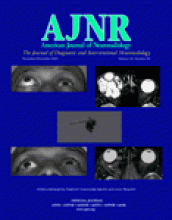Research ArticleINTERVENTIONAL
Intravenous Glycoprotein IIb/IIIa Inhibitor (Tirofiban) followed by Intra-Arterial Urokinase and Mechanical Thrombolysis in Stroke
Salvatore Mangiafico, Martino Cellerini, Patrizia Nencini, Gianfranco Gensini and Domenico Inzitari
American Journal of Neuroradiology November 2005, 26 (10) 2595-2601;
Salvatore Mangiafico
Martino Cellerini
Patrizia Nencini
Gianfranco Gensini

References
- 1.↵The National Institute of Neurological Disorders and Stroke rt-PA Stroke Study Group. Tissue plasminogen activator for acute ischemic stroke. N Engl J Med 1995;333:1581–1587
- 2.↵Bourekas EC, Slivka AP, Shah R, et al. Intraarterial thrombolytic therapy within 3 hours of the onset of stroke. Neurosurgery 2004;54:39–46
- 3.↵Alexandrov AV, Grotta JC. Arterial reocclusion in stroke patients treated with intravenous tissue plasminogen activator. Neurology 2002;59:862–867
- 4.↵Del Zoppo GJ, Higashida RT, Furlan AJ, et al. PROACT: a phase II randomised trial of recombinant pro-urokinase by direct arterial delivery in acute middle cerebral artery stroke: PROACT Investigators: Prolyse in Acute Cerebral Thromboembolism. Stroke 1998;29:4–11
- 5.↵Furlan A, Higashida R, Wechsler L, et al. Intra-arterial prourokinase for acute ischemic stroke: the PROACT II study: a randomized controlled trial. Prolyse in Acute Cerebral Thromboembolism. JAMA 1999;282:2003–2011
- 6.↵Lewandowsky CA, Frankel M, Tomsick TA, et al. Combined intra-venous and intra-arterial rtPA versus intra-arterial therapy of acute ischemic stroke : Emergency Management of Stroke (EMS) Bridging Trial. Stroke 1999;30:2598–2605
- 7.↵IMS Study Investigators. Combined intravenous and intra-arterial recanalization for acute ischemic stroke: the Interventional Management of Stroke Study. Stroke 2004;35:904–912
- 8.↵
- 9.Platelet Receptor Inhibition in Ischemic Syndrome Management in Patients Limited by Unstable Signs and Symptoms (PRISM-PLUS) Study Investigators. Inhibition of the platelet glycoprotein IIb/IIIa receptor with tirofiban in unstable angina and non-Q-wave myocardial infarction. N Engl J Med 1998;338:1488–1497
- 10.↵Straub S, Junghans U, Jovanovic V, et al. Systemic thrombolysis with recombinant tissue plasminogen activator and tirofiban in acute middle cerebral artery occlusion. Stroke 2004;35:705–709
- 11.↵Eckert B, Koch C, Thomalla G, et al. Acute basilar artery occlusion treated with combined intravenous abciximab and intra-arterial tissue plasminogen activator: report of 3 cases. Stroke 2002;33:1424–1427
- 12.↵Cloft HJ, Samuels OB, Tong FC, Dion JE. Use of abciximab for mediation of thromboembolic complications of endovascular therapy. AJNR Am J Neuroradiol 2001;22:1764–1767
- 13.↵Barber PA, Demehuk AM, Zhang J, Buchan AM, for the ASPECT Study Group. Validity and reliability of a quantitative computed tomography score in predicting outcome of hyperacute stroke before thrombolytic therapy: Alberta Stroke Programme early CT score. Lancet 2000;355:1670–1674
- 14.↵Deshmukh VR, Fiorella DJ, Albuquerque FC, et al. Intra-arterial thrombolysis for acute ischemic stroke: preliminary experience with platelet glycoprotein IIb/Iia inhibitors as adjunctive therapy. Neurosurgery 2005;56:46–55
- 15.↵RC Lisboa, BD Jovanovic, MJ Alberts. Analysis of the safety and efficacy of intra-arterial thrombolytic therapy in ischemic stroke. Stroke 2002;33:2866–2871
- 16.↵Adams H. Effect of abciximab for acute ischemic stroke: final results of Abciximab in Emergent Stroke Treatment Trial (AbESTT) presented at the 28th International Stroke Conference February 2003. Stroke 2003;34:252
- 17.↵Seitz RJ, Hamzavi M, Junghans U, et al. Thrombolysis with recombinant tissue plasminogen activator and tirofiban in stroke: preliminary observations. Stroke 2003;34:1932–1935
- 18.↵Cheung RT, Ho DS. Fatal hemorrhagic transformation of acute cerebral infarction after the use of abciximab. Stroke 2000;31:2526–2527
- 19.↵Qureshi AL, Saad M, Zaidat OO, et al. Intracerebral hemorrhages associated with neurointerventional procedures using a comination of antithrombotic agents including abciximab. Stroke 2002;33:1916–1919
- 20.↵Ueda T, Sakaki S, Nochide I, et al Angioplasty after intra-arterial thrombolysis for acute occlusion of intracranial arteries. Stroke 1998;29:2568–2574
- 21.↵Abumiya T, Fitridge R, Mazur C, et al. Integrin alfa(IIb)beta(3) inhibitor preserves microvascular patency in experimental acute focal cerebral schemia. Stroke 2000 :31 ;1402–1410
- 22.↵Fassbender K, Dempfle CE, Mielke O, et al. Changes in coagulation and fibrinolysis markers in acute ischemic stroke treated with recombinant tissue plasminogen activator. Stroke 1999;30:2101–2104
- 23.↵Siess W. Molecular mechanisms of platelet activation. Physiol Rev 1989;69:58–178
- 25.↵Weitz JI, Leslie B, Hudoba M. Thrombin binds to soluble fibrin degradation products where it is protected from inhibition by heparin-antithrombin but susceptible to inactivation by antithrombin-independent inhibitors. Circulation 1998;97:544–552
- 26.↵Junghans U, Seitz RJ, Aulich A, et al. Bleeding risk of tirofiban, a nonpeptide GPIIb/IIIa platelet receptor antagonist in progressive stroke: an open pilot study. Cerebrovasc Dis 2001;12:308–312
- 27.Tcheng JE. Clinical challenges of platelet glycoprotein IIb/IIIa receptor inhibitor therapy: bleeding, reversal, thrombocytopenia, and retreatment. Am Heart J 2000;139:S38–S45
In this issue
Advertisement
Salvatore Mangiafico, Martino Cellerini, Patrizia Nencini, Gianfranco Gensini, Domenico Inzitari
Intravenous Glycoprotein IIb/IIIa Inhibitor (Tirofiban) followed by Intra-Arterial Urokinase and Mechanical Thrombolysis in Stroke
American Journal of Neuroradiology Nov 2005, 26 (10) 2595-2601;
0 Responses
Jump to section
Related Articles
- No related articles found.
Cited By...
- Recanalisation therapy in patients with acute ischaemic stroke caused by large artery occlusion: choice of therapeutic strategy according to underlying aetiological mechanism?
- Low-Dose Tirofiban Improves Functional Outcome in Acute Ischemic Stroke Patients Treated With Endovascular Thrombectomy
- Targeting Integrin and Integrin Signaling in Treating Thrombosis
- Potential for the Use of the Solitaire Stent for Recanalization of Middle Cerebral Artery Occlusion without a Susceptibility Vessel Sign
- Guidelines for the Early Management of Patients With Acute Ischemic Stroke: A Guideline for Healthcare Professionals From the American Heart Association/American Stroke Association
- Periprocedural antithrombotic strategies in acute ischemic stroke interventional therapy
- Predictors of Subarachnoid Hemorrhage in Acute Ischemic Stroke With Endovascular Therapy
- Safety and Effectiveness of Endovascular Therapy After 8 Hours of Acute Ischemic Stroke Onset and Wake-Up Strokes
- Endovascular Approaches to Acute Stroke, Part 1: Drugs, Devices, and Data
- Stent-Assisted Endovascular Thrombolysis Versus Intravenous Thrombolysis in Internal Carotid Artery Dissection With Tandem Internal Carotid and Middle Cerebral Artery Occlusion
- Intra-arterial therapies for acute ischemic stroke
- Complete occlusion of extracranial internal carotid artery: clinical features, pathophysiology, diagnosis and management
This article has not yet been cited by articles in journals that are participating in Crossref Cited-by Linking.
More in this TOC Section
Similar Articles
Advertisement











